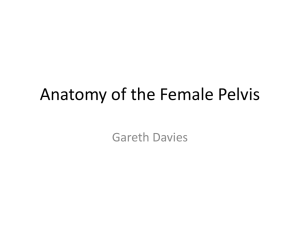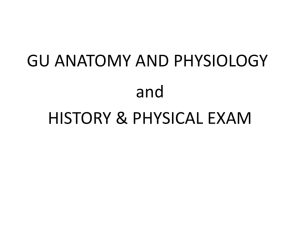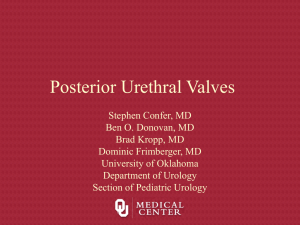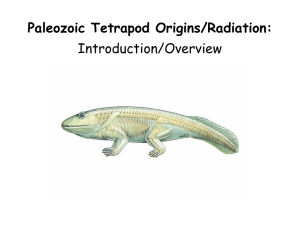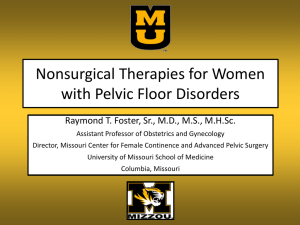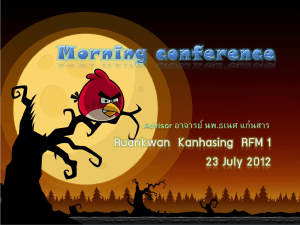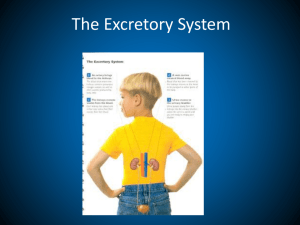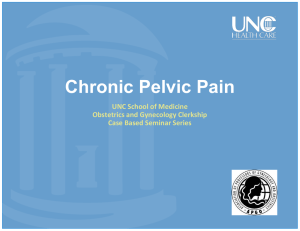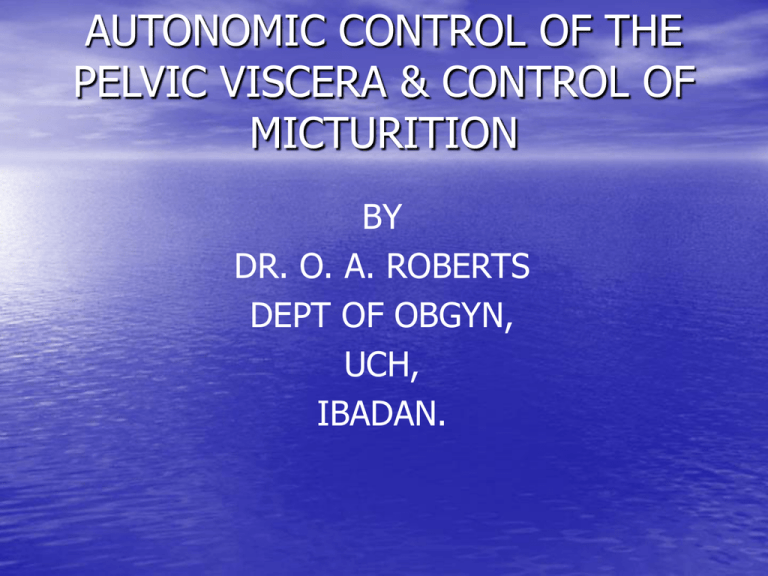
AUTONOMIC CONTROL OF THE
PELVIC VISCERA & CONTROL OF
MICTURITION
BY
DR. O. A. ROBERTS
DEPT OF OBGYN,
UCH,
IBADAN.
AUTONOMIC CONTROL OF
THE PELVIC VISCERA
AUTONOMIC SYSTEM OF NERVES:
Lies- Sidewall of Pelvis lat. to Rectum
Sympathetic: Fibres From Hypogastric Plexus plus
upper sacral ganglia of the Sypathetic Trunk. The
plexus is ganglionated (T11&12).
Pre-ganglionic Fibres (half) synapse here while
post-g. do not Synapse.
Parasympathetic fibres only synapse in the Visceral
walls. Arising from S 2-4 bodies (Nervi Erigentes)
SYMPATHETIC FIBRES = VASOCONSTRICTOR
PARASYPATHETIC = MOTOR TO BLADDER, GUT &
SECRETOMOTOR TO GUT GLANDS.
AUTONOMIC CONTROL OF THE
PELVIC VISCERA
• THE SYMPATHETIC FIBRES ARE MOTOR TO
SMTH. MUSCLE OF BLADDER & ANAL
SPHINCTERS.
• COURSE OF PAIN AND SENSORY FIBRES
COMPLEX:
• MOST TRAVEL WITH SYMP. SYSTEM,
ESPECIALLY, FROM GUT & GONADS.
THOSE FROM BLADDER & RECTUM ?TRAVEL IN
NERVI ERIGENTIS. SAME FOR CERVIX
UTERINE FIBRES FOLLOW HYPOGASRIC NN. TO
DORSAL NERVE ROOTS OF T11 & 12.
AUTONOMIC CONTROL OF THE
PELVIC VISCERA
• THE VAGINAL SUPPLY:
– Sympathetic ganglia in Lower Lumbar via
Hypogastric plexus.
– Parasymp. Outflow S2-4 (nervi erigentis).
– N.B. Nerve endings undecorated but
PACINIAN copuscles found in adventitia.
•VULVAL SUPPLY:
–Postganglionic Symp. Fibres from
Hypogastric plex. Via Pudendal Nn.
–Parasympathetic S2-4 as Nervi Erigentis
to join the pelvic plexus.
CONTROL OF MICTURITION
• BLADDER = HOLLOW MUSC. ORGAN BEHIND
•
•
•
SYMPHISIS. MADE UP OF SMOOTH MUSCLE
SYNCITIUM.
DETRUSOR MUSCLE= ↑Achase parasympathetic
Nn S2-4
BLADDER DOME, URETHRA, BLADDER NECK = ß
& α Adrenergic receptor symp. Outflow T10 - L2.
RHABDOSPHINCTER URETHRAE: Striated mm. in
the middle of urethra – circularly arranged
(External Sphincter or INTRINSIC SPHINCTER
MECHANISM). FOR URETHRAL CLOSURE AT
REST
CONTROL OF MICTURITION
• S2-4 Nn. Roots traveling with Pelvic Splanchnic
Nn. Supply smooth muscle of the urethra
(longitudinally arranged & continuous with
detrusor).
• EXTRINSIC SPHINCTER MECHANISM:
– Striated periurethral Mm (Levator ani) at junction of
middle & lower 1/3 of the Urethra.
• For additional closure force at times of physical
effort
BOTH mechanisms Maintain greater I.U.P. than
I.V.P. Ξ +VE Closure pressure.
CONTROL OF MICTURITION
• Visceral Afferents => thoracolumbar nn & sacral
efferents conveying the sensation of Bladder
distention.
• CNS control of Micturition:
Complex, requiring a sacral spinal reflex arc
modulated by frontal lobe, thalamus, B.G. &
hypothalamus:
Bladder stretch receptors => Visc. Afferents =>
(with Pelvic Splanch. Nn.)
=> S2-4 Cord =>Controlled by Excitatory &
Inhibitory receptor Centres which prevent Detrusor
contractions & maintain Urethra sphincter control.
CONTROL OF MICTURITION
PHYSIOLOGY:
• Storage Phase
• I.V.P. = 10cm H2O
• Gradual filling to 150-250ml => When 400600ml of urine => Desire to void, I.V.P. =
25cm H2O.
• Beyond this => Irresistible urge to void =>
release of cortical inhibition & voiding.
CONTROL OF MICTURITION
Voiding Phase
• Relaxation of Pelvic Floor mm., Intrinsic
straited mm. of the Urethra, fall in I.U.P..
Then efferent Parsymp. Detrus or stim. &
contration (max 60cm H2O ). Once voiding
in progress, I.V. P constant. Detusor mm
efficiency ↑ with shortening of the Fibres,
hence less force is reqd to maintain Mict.
• N. B.Interruption is by contr. of Extrinsic
Striated mm. of Pelvic floor.
Thank you


